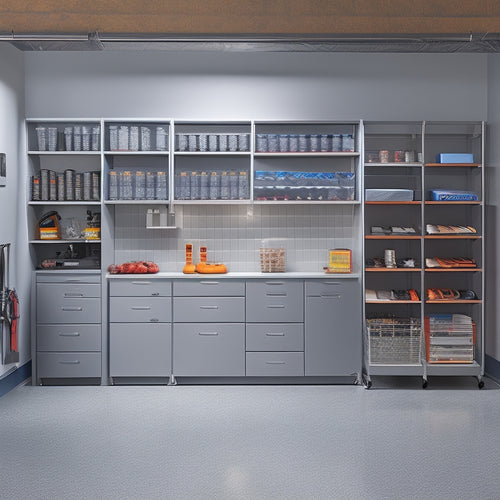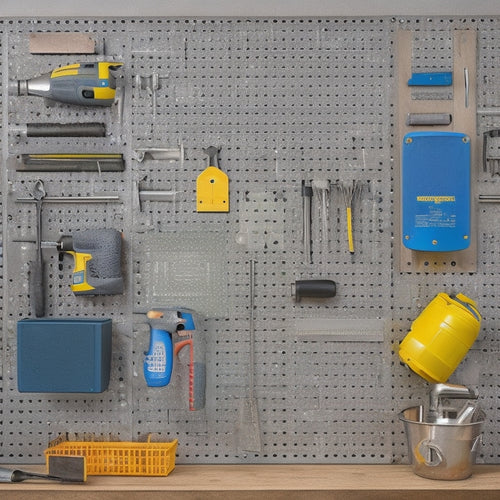
7 Essential Tips for Tool Storage in Small Spaces
Share
You're struggling to keep your tool collection organized in your small workspace. To maximize your space, start by evaluating and categorizing your tools, and identify essential ones for easy access. Choose storage containers that optimize storage capacity and label them for quick identification. Make the most of your vertical space by installing shelves, hooks, or pegboards. Implement a 'one in, one out' policy to maintain a balanced tool collection. Optimize your workbench area by designating zones for different tasks and using vertical storage for tools and accessories. By following these tips, you'll be well on your way to a more efficient and organized workspace, and discover even more ways to fine-tune your tool storage strategy.
Key Takeaways
• Categorize tools by function, frequency of use, and size to identify essential tools and optimize storage space.
• Utilize vertical space by installing shelves, hooks, or pegboards to maximize storage capacity in small areas.
• Implement a 'one in, one out' policy to maintain a balanced tool collection and prevent clutter.
• Choose multi-functional tools to reduce the number of tools needed, free up storage space, and minimize clutter.
• Label and categorize tools for quick identification, and store most-used tools in accessible locations to enhance workflow efficiency.
Assess Your Tool Collection
Take stock of your tool collection by gathering every item, from screwdrivers to power tools, and categorizing them by function, frequency of use, and size. This pivotal step will help you identify what you have, what you need, and what you can get rid of.
As you sort through your tools, consider how often you use each item and prioritize the most essential ones. This will help you determine which tools require easy access and which can be stored away.
Next, think about the space-saving solutions you can implement to maximize your storage capacity. Consider the dimensions of your tools and how you can store them in a compact manner. Look for opportunities to stack, hang, or nest tools to make the most of your available space.
Choose the Right Storage
When choosing the right storage for your tools, you'll want to think strategically about how to make the most of your small space.
You'll need to select containers that optimize storage capacity and make it easy to access the tools you need.
Optimize Storage Containers
You'll get the most out of your small space by selecting storage containers that are specifically designed to meet your tool storage needs. This is where container organization comes in - choosing containers that are tailored to your tools and the space you have available is fundamental. Look for space-saving solutions like compact toolboxes or hanging systems that can be mounted on walls or ceilings, freeing up floor space.
When selecting containers, consider the size and shape of your tools. For example, if you have a lot of long, thin tools like screwdrivers or wrenches, look for containers with narrow compartments. If you have bulkier tools like drills or saws, opt for containers with larger storage areas.
Labeling your containers is also vital, so you can quickly identify what's inside without having to dig through everything.
Maximize Vertical Space
By installing shelves, hooks, or pegboards, you can capitalize on the often-wasted vertical space in your small shop or garage, doubling or even tripling your storage capacity. This will help you make the most of your limited space and keep your tools organized and within reach.
To maximize your vertical space, consider the following:
-
Install ceiling hooks to hang items like bikes, tools, or accessories, freeing up floor space and keeping them out of the way.
-
Use hanging baskets or bins to store small items like nuts, bolts, or screws, keeping them organized and easy to find.
-
Implement pegboard organization by attaching pegs to a board and hanging your tools, making it easy to grab what you need quickly.
- Add magnetic strips to your pegboard or shelves to store metal tools, keeping them organized and preventing them from getting lost or damaged.
Utilize Vertical Space Efficiently
When working with a small space, you'll want to make the most of your walls and shelves.
By maximizing your wall space and optimizing shelf height, you can efficiently store more tools without taking up valuable floor space.
This will allow you to keep your tools organized and easily accessible, making your workflow more efficient.
Maximize Wall Space
To make the most of your small space, hang tool organizers, pegboards, or slatwalls on your walls to keep frequently used items within easy reach. This will help you maximize your wall space and keep your tools organized.
You can create a DIY pegboard using magnetic strips to hang your tools, making it easy to access them when you need them.
Here are some additional tips to maximize your wall space:
-
Use hanging hooks to hang items like bikes, ladders, or wheelbarrows, keeping them off the floor and out of the way.
-
Install hidden storage compartments behind wall-mounted shelves or cabinets to store small items like nuts and bolts.
-
Consider using a fold-down workbench that can be mounted on the wall, providing a convenient workspace when you need it.
- Utilize the space above your workbench by installing a shelf or cabinet to store less frequently used items.
Optimize Shelf Height
You can greatly increase your storage capacity by optimizing shelf height to match the size of your tools and supplies, ensuring everything fits snugly without wasting valuable vertical space. By adjusting shelf heights, you'll create a more efficient and organized storage system. This is especially crucial in small spaces where every inch counts.
Start by grouping similar items together and measuring their heights. Then, adjust your shelves to accommodate the tallest item in each group. This will guarantee that you're making the most of your vertical space. Consider using space-saving solutions like stackable bins or hanging organizers to maximize storage capacity.
Don't be afraid to get creative and think outside the box – or in this scenario, the shelf. By optimizing your shelf heights, you'll be able to store more tools and supplies in a smaller area, making it easier to find what you need when you need it. With a little planning and creativity, you can turn even the smallest space into a well-organized and efficient tool storage area.
Label and Categorize Tools
Your toolkit's efficiency hinges on a well-organized system, starting with labeling and categorizing tools to guarantee easy access and quick identification. By doing so, you'll save time searching for the right tool and reduce frustration.
To get started, sort your tools into categories, such as hand tools, power tools, and fasteners. Then, assign a specific color code to each category using labels or stickers. This visual system will help you quickly locate the tool you need.
Consider the following strategies to take your labeling and categorizing to the next level:
-
Use a pegboard to hang frequently used tools, making them easily accessible and visible.
-
Organize your tool chest by grouping similar tools together, such as all screwdrivers or pliers.
-
Label each tool with its name and category, ensuring you can quickly identify it.
- Designate a specific area for tools that need maintenance or repair, so you can address them promptly.
Implement a "One In, One Out" Policy
As your collection of tools grows, an important aspect of maintaining a well-organized space is adopting a 'one in, one out' policy, ensuring that every new tool acquired prompts the removal or repurposing of an old one. This approach helps maintain a balanced tool collection, preventing clutter and chaos in your small space. By implementing this policy, you'll avoid the temptation to hold onto unnecessary tools, making it easier to focus on the essentials.
In the decluttering process, you'll identify tools that are no longer serving a purpose or are duplicates. Remove or repurpose them to make room for new, more efficient tools. This tool rotation concept allows you to refresh your collection without overcrowding your space.
Optimize Your Workbench Area
Once your tool collection is streamlined, focus on configuring your workbench area to maximize efficiency and accessibility. A well-organized workbench is pivotal in a small space, as it helps you stay focused and avoid wasting time searching for tools.
Here are some tips to help you optimize your workbench area:
-
Designate zones: Divide your workbench into separate zones for different tasks, such as a power tool zone, a hand tool zone, and a workspace zone.
-
Use vertical storage: Install pegboards, hooks, or shelves to store tools and accessories, keeping them off the work surface and out of the way.
-
Choose multi-functional tools: Select tools that serve multiple purposes, reducing clutter and increasing efficiency.
- Keep frequently used tools accessible: Store your most-used tools in easy-to-reach locations, such as in a tool chest or on a nearby shelf.
Consider Multi-Functional Tools
By opting for multi-functional tools, you can greatly reduce the number of tools you need to store and maintain, freeing up valuable space in your small workshop. This approach not only saves space but also reduces clutter, making it easier to find what you need when you need it. Consider investing in tools that serve multiple purposes, such as a cordless drill that also functions as a driver or a wrench with interchangeable heads.
Here are some examples of multi-functional tools that can help optimize your tool storage:
| Tool | Functions |
|---|---|
| Cordless drill | Drill, driver, screwdriver |
| Wrench | Pliers, screwdriver, wire cutter |
| Pocket knife | Knife, scissors, bottle opener |
| Multitool | Pliers, wire cutter, file, knife |
| Drill bit set | Drill bits for various materials |
Frequently Asked Questions
How Do I Store Power Tools With Cords and Batteries Safely?
You'll want to prioritize cord organization and battery maintenance when storing power tools with cords and batteries safely. Utilize space-saving solutions like tool wall racks to keep them organized and within reach.
Are Soft Pouches or Hard Cases Better for Tool Protection?
Coincidentally, you're wondering about the best protection for your tools, and it's vital! Soft pouches offer flexible storage and easy access, while hard cases provide ultimate protection from drops and scratches - weigh the pros and cons to choose the best fit for your tool protection needs.
Can I Store Tools in a Humid or Damp Environment?
You shouldn't store tools in humid or damp environments, as they can rust quickly. Instead, promote proper ventilation, utilize dehumidifiers, and seal containers to prevent moisture buildup, thereby maintaining rust prevention and keeping your tools in top condition.
How Often Should I Clean and Maintain My Tool Storage?
You're worried cleaning and maintaining your tool storage is a hassle, but trust us, it's worth it! Set a maintenance schedule to clean your tools and storage every 2-3 months to prevent rust and keep them in top shape.
Are Tool Storage Systems Worth the Investment for Diyers?
You're wondering if tool storage systems are worth the investment for DIY projects. Honestly, they are if you consider your budget and prioritize space-saving solutions that boost organization and efficiency in your workspace.
Related Posts
-

Large Wall Hooks to Maximize Garage Space
You can effectively double your garage's storage capacity by installing large wall hooks that keep items off the floo...
-

Building a Garage Storage System With Built-Ins
You're about to build a garage storage system with built-ins that fits your unique needs, starting by evaluating your...
-

How to Hang a Pegboard in 5 Easy Steps
You'll hang a pegboard in 5 easy steps by first preparing the wall, ensuring it's sturdy and free of obstructions. Ne...


